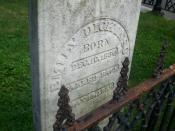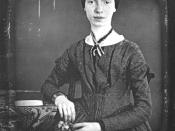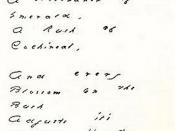Emily Dickinson's poems "Because I Could Not Stop for Death", "I Heard A Fly Buzz-When I Died", and "I Felt A Funeral In My Brain" all acknowledge one of life's undisputable phenomenon's, death. Much of Dickinson's work showed her interests in mortality, and in these three poems, her interests in exploring death are evident. Her curiosity lead her to the question of what happens after death. Do you go to heaven, to nothing, or to a new life?
"Because I could Not Stop for Death" is one of Emily Dickinson's most famous poems. Death in this poem is translated as a woman's last trip headed toward eternity. This poem helps to characterize and relate to death on a more personal level. Dickinson makes death seem passive and easy, which is different from most views of death being brutal and cruel. The theme of the poem is that death is natural and unstoppable for everybody, but at the same time giving comfort that it is not the end of a soul's journey.
"Because I Could Not Stop for Death" starts to gives the reader a feeling of forward movement throughout the second and third stanza. In Line 5, Dickinson begins death's journey slowly which can be seen as she writes, "We slowly drove-He knew no haste." The third stanza seems to speed up as the trinity of death, immortality, and the speaker pass the playing children, the grain fields, and the setting sun. The poem seems to get faster as Life goes through its course, but in lines 17 and 18, however, the poem seems to slow down as Dickinson writes, "We paused before a House that seemed / A Swelling of the Ground-." She gives a feeling of life winding down. In line 4,


